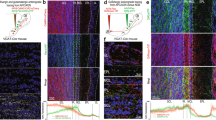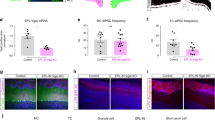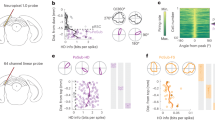Abstract
Lateral inhibition is a circuit motif found throughout the nervous system that often generates contrast enhancement and center-surround receptive fields. We investigated the functional properties of the circuits mediating lateral inhibition between olfactory bulb principal neurons (mitral cells) in vitro. We found that the lateral inhibition received by mitral cells is gated by postsynaptic firing, such that a minimum threshold of postsynaptic activity is required before effective lateral inhibition is recruited. This dynamic regulation allows the strength of lateral inhibition to be enhanced between cells with correlated activity. Simulations show that this regulation of lateral inhibition causes decorrelation of mitral cell activity that is evoked by similar stimuli, even when stimuli have no clear spatial structure. These results show that this previously unknown mechanism for specifying lateral inhibitory connections allows functional inhibitory connectivity to be dynamically remapped to relevant populations of neurons.
This is a preview of subscription content, access via your institution
Access options
Subscribe to this journal
Receive 12 print issues and online access
$209.00 per year
only $17.42 per issue
Buy this article
- Purchase on Springer Link
- Instant access to full article PDF
Prices may be subject to local taxes which are calculated during checkout






Similar content being viewed by others
References
Hirsch, J.A. & Gilbert, C.D. Synaptic physiology of horizontal connections in the cat's visual cortex. J. Neurosci. 11, 1800–1809 (1991).
Urban, N.N. Lateral inhibition in the olfactory bulb and in olfaction. Physiol. Behav. 77, 607–612 (2002).
Friedrich, R.W. & Laurent, G. Dynamic optimization of odor representations by slow temporal patterning of mitral cell activity. Science 291, 889–894 (2001).
Linster, C., Sachse, S. & Galizia, C.G. Computational modeling suggests that response properties rather than spatial position determine connectivity between olfactory glomeruli. J. Neurophysiol. 93, 3410–3417 (2005).
Kuffler, S.W. Discharge patterns and functional organization of mammalian retina. J. Neurophysiol. 16, 37–68 (1953).
Bosking, W.H., Zhang, Y., Schofield, B. & Fitzpatrick, D. Orientation selectivity and the arrangement of horizontal connections in tree shrew striate cortex. J. Neurosci. 17, 2112–2127 (1997).
Jahr, C.E. & Nicoll, R.A. An intracellular analysis of dendrodendritic inhibition in the turtle in vitro olfactory bulb. J. Physiol. (Lond.) 326, 213–234 (1982).
Uchida, N., Takahashi, Y.K., Tanifuji, M. & Mori, K. Odor maps in the mammalian olfactory bulb: domain organization and odorant structural features. Nat. Neurosci. 3, 1035–1043 (2000).
Takahashi, Y.K., Kurosaki, M., Hirono, S. & Mori, K. Topographic representation of odorant molecular features in the rat olfactory bulb. J. Neurophysiol. 92, 2413–2427 (2004).
Friedrich, R.W. & Korsching, S.I. Combinatorial and chemotopic odorant coding in the zebrafish olfactory bulb visualized by optical imaging. Neuron 18, 737–752 (1997).
Malnic, B., Hirono, J., Sato, T. & Buck, L.B. Combinatorial receptor codes for odors. Cell 96, 713–723 (1999).
Egger, V. & Urban, N.N. Dynamic connectivity in the mitral cell-granule cell microcircuit. Semin. Cell Dev. Biol. 17, 424–432 (2006).
Willhite, D.C. et al. Viral tracing identifies distributed columnar organization in the olfactory bulb. Proc. Natl. Acad. Sci. USA. 103, 12592–12597 (2006).
Rubin, B.D. & Katz, L.C. Optical imaging of odorant representations in the mammalian olfactory bulb. Neuron 23, 499–511 (1999).
Meister, M. & Bonhoeffer, T. Tuning and topography in an odor map on the rat olfactory bulb. J. Neurosci. 21, 1351–1360 (2001).
Shepherd, G.M. & Greer, C.A. Olfactory bulb. in The Synaptic Organization of the Brain (ed. Shepherd, G.M.) (Oxford University Press, New York, 2004).
Schoppa, N.E. & Urban, N.N. Dendritic processing within olfactory bulb circuits. Trends Neurosci. 26, 501–506 (2003).
Orona, E., Rainer, E.C. & Scott, J.W. Dendritic and axonal organization of mitral and tufted cells in the rat olfactory bulb. J. Comp. Neurol. 226, 346–356 (1984).
Mori, K., Kishi, K. & Ojima, H. Distribution of dendrites of mitral, displaced mitral, tufted and granule cells in the rabbit olfactory bulb. J. Comp. Neurol. 219, 339–355 (1983).
Price, J.L. & Powell, T.P. The synaptology of the granule cells of the olfactory bulb. J. Cell Sci. 7, 125–155 (1970).
Kapfer, C., Glickfeld, L.L., Atallah, B.V. & Scanziani, M. Supralinear increase of recurrent inhibition during sparse activity in the somatosensory cortex. Nat. Neurosci. 10, 743–753 (2007).
Laurent, G. A systems perspective on early olfactory coding. Science 286, 723–728 (1999).
Dietz, S.B. & Murthy, V.N. Contrasting short-term plasticity at two sides of the mitral-granule reciprocal synapse in the mammalian olfactory bulb. J. Physiol. (Lond.) 569, 475–488 (2005).
Abraham, N.M. et al. Maintaining accuracy at the expense of speed: stimulus similarity defines odor discrimination time in mice. Neuron 44, 865–876 (2004).
Uchida, N. & Mainen, Z.F. Speed and accuracy of olfactory discrimination in the rat. Nat. Neurosci. 6, 1224–1229 (2003).
Kapoor, V. & Urban, N.N. Glomerulus-specific, long-latency activity in the olfactory bulb granule cell network. J. Neurosci. 26, 11709–11719 (2006).
Urban, N.N. & Sakmann, B. Reciprocal intraglomerular excitation and intra- and interglomerular lateral inhibition between mouse olfactory bulb mitral cells. J. Physiol. (Lond.) 542, 355–367 (2002).
Margrie, T.W., Sakmann, B. & Urban, N.N. Action potential propagation in mitral cell lateral dendrites is decremental and controls recurrent and lateral inhibition in the mammalian olfactory bulb. Proc. Natl. Acad. Sci. USA 98, 319–324 (2001).
Isaacson, J.S. & Strowbridge, B.W. Olfactory reciprocal synapses: dendritic signaling in the CNS. Neuron 20, 749–761 (1998).
Schoppa, N.E. & Westbrook, G.L. Regulation of synaptic timing in the olfactory bulb by an A-type potassium current. Nat. Neurosci. 2, 1106–1113 (1999).
Friedrich, R.W. & Stopfer, M. Recent dynamics in olfactory population coding. Curr. Opin. Neurobiol. 11, 468–474 (2001).
Wilson, R.I., Turner, G.C. & Laurent, G. Transformation of olfactory representations in the Drosophila antennal lobe. Science 303, 366–370 (2004).
Stopfer, M., Jayaraman, V. & Laurent, G. Intensity versus identity coding in an olfactory system. Neuron 39, 991–1004 (2003).
Schoppa, N.E. & Westbrook, G.L. AMPA autoreceptors drive correlated spiking in olfactory bulb glomeruli. Nat. Neurosci. 5, 1194–1202 (2002).
Carlson, G.C., Shipley, M.T. & Keller, A. Long-lasting depolarizations in mitral cells of the rat olfactory bulb. J. Neurosci. 20, 2011–2021 (2000).
Schoppa, N.E., Kinzie, J.M., Sahara, Y., Segerson, T.P. & Westbrook, G.L. Dendrodendritic inhibition in the olfactory bulb is driven by NMDA receptors. J. Neurosci. 18, 6790–6802 (1998).
Egger, V., Svoboda, K. & Mainen, Z.F. Dendrodendritic synaptic signals in olfactory bulb granule cells: local spine boost and global low-threshold spike. J. Neurosci. 25, 3521–3530 (2005).
Egana, J.I., Aylwin, M.L. & Maldonado, P.E. Odor response properties of neighboring mitral/tufted cells in the rat olfactory bulb. Neuroscience 134, 1069–1080 (2005).
Mori, K., Takahashi, Y.K., Igarashi, K.M. & Yamaguchi, M. Maps of odorant molecular features in the mammalian olfactory bulb. Physiol. Rev. 86, 409–433 (2006).
Johnson, B.A., Farahbod, H., Xu, Z., Saber, S. & Leon, M. Local and global chemotopic organization: general features of the glomerular representations of aliphatic odorants differing in carbon number. J. Comp. Neurol. 480, 234–249 (2004).
Leutgeb, S., Leutgeb, J.K., Moser, M.B. & Moser, E.I. Place cells, spatial maps and the population code for memory. Curr. Opin. Neurobiol. 15, 738–746 (2005).
Wang, Y., Fujita, I. & Murayama, Y. Neuronal mechanisms of selectivity for object features revealed by blocking inhibition in inferotemporal cortex. Nat. Neurosci. 3, 807–813 (2000).
Acknowledgements
Thanks to A.T. Schaefer and members of the Urban laboratory for helpful comments and discussion. This work was supported by the grants from the National Institute of Deafness and Other Communication Disorders (F30 DC008274, A.A.; R01 DC005798, N.U.) and by a fellowship from the National Science Foundation Integrative Graduate Education and Research Traineeship program (NSF DGE-9987588, A.A.).
Author information
Authors and Affiliations
Contributions
A.A. and N.U. designed all experiments (including computational) except for those in Figure 5, which were designed by V.K. and N.U. A.A. conducted and analyzed all experiments except for those in Figure 5, which were conducted and analyzed by V.K. A.A. and N.U. wrote the manuscript.
Corresponding author
Supplementary information
Supplementary Text and Figures
Supplementary Figures 1–3 (PDF 1941 kb)
Rights and permissions
About this article
Cite this article
Arevian, A., Kapoor, V. & Urban, N. Activity-dependent gating of lateral inhibition in the mouse olfactory bulb. Nat Neurosci 11, 80–87 (2008). https://doi.org/10.1038/nn2030
Received:
Accepted:
Published:
Issue Date:
DOI: https://doi.org/10.1038/nn2030
This article is cited by
-
Olfactory bulb granule cells: specialized to link coactive glomerular columns for percept generation and discrimination of odors
Cell and Tissue Research (2021)
-
Whitening of odor representations by the wiring diagram of the olfactory bulb
Nature Neuroscience (2020)
-
Bilateral and unilateral odor processing and odor perception
Communications Biology (2020)
-
Mosaic representations of odors in the input and output layers of the mouse olfactory bulb
Nature Neuroscience (2019)
-
Inhibition increases response variability and reduces stimulus discrimination in random networks of cortical neurons
Scientific Reports (2019)



